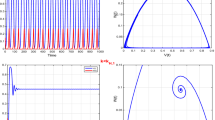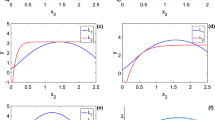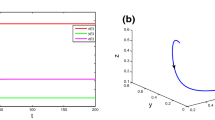Abstract
In this paper, we couple population dynamics and evolutionary game theory to establish a prey–predator system in which individuals in the predator population need to choose between group hunting strategies and isolated hunting strategies. This system includes two types of delay: fitness delay and hunting delay. In the absence of delays, we discuss the stability of boundary and interior equilibria. In addition, the condition that the non-delayed system undergoes transcritical bifurcation is obtained. For the delayed system, we explore the stability of the interior equilibrium and obtain the conditions for the existence of Hopf bifurcation. The conditions for determining the direction and stability of the Hopf bifurcation and the periodic variation in the periodic solution are introduced by using the normal form theory and center manifold theory. Finally, we simulate non-delayed and delayed systems. The results indicate that when the availability of prey is high, the isolated hunting strategy is the dominant strategy. When the availability of prey is low, mixed strategies appear and the proportion of the group hunting strategy increases as the availability of prey decreases. Furthermore, large delays lead to the disappearance of the mixed hunting strategy and its replacement by pure hunting strategies.














Similar content being viewed by others
Availability of data and materials
Data sharing is not applicable to this article as no datasets were generated or analyzed during the current study.
References
Abbass H, Greenwood G, Petraki E (2016) The \( n \)-player trust game and its replicator dynamics. IEEE Trans Evol Comput 20(3):470–474. https://doi.org/10.1109/tevc.2015.2484840
Andrzejaczek S, Gleiss AC, Lear KO, Pattiaratchi C, Chapple TK, Meekan MG (2020) Depth-dependent dive kinematics suggest cost-efficient foraging strategies by tiger sharks. R Soc Open Sci 7(8):200789. https://doi.org/10.1098/rsos.200789
Bailey I, Myatt JP, Wilson AM (2012) Group hunting within the carnivora: physiological, cognitive and environmental influences on strategy and cooperation. Behav Ecol Sociobiol 67(1):1–17. https://doi.org/10.1007/s00265-012-1423-3
Banerjee S, Sha A, Chattopadhyay J (2020) Cooperative predation on mutualistic prey communities. J Theor Biol 490:110156. https://doi.org/10.1016/j.jtbi.2020.110156
Bednarz JC (1988) Cooperative hunting Harris’ hawks (parabuteo unicinctus). Science 239(4847):1525–7. https://doi.org/10.1126/science.239.4847.1525
Belardi JB, Marina FC, Madrid P, Barrientos G, Campan P (2017) Late holocene guanaco hunting grounds in southern patagonia: blinds, tactics and differential landscape use. Antiquity 91(357):718–731. https://doi.org/10.15184/aqy.2017.20
Cazaubiel A, Lutz AF, Arenzon JJ (2017) Collective strategies and cyclic dominance in asymmetric predator–prey spatial games. J Theor Biol 430:45–52. https://doi.org/10.1016/j.jtbi.2017.07.002
Chen S, Bao FS (2015) Linking body size and energetics with predation strategies: a game theoretic modeling framework. Ecol Model 316:81–86. https://doi.org/10.1016/j.ecolmodel.2015.07.033
Cheng H, Meng X, Hayat T, Hobiny A, Zhang T (2022) Stability and bifurcation analysis for a nitrogen-fixing evolutionary game with environmental feedback and discrete delays. Int J Bifurc Chaos 32(02):2250027. https://doi.org/10.1142/S0218127422500274
Chowdhury SN, Kundu S, Perc M, Ghosh D (2021) Complex evolutionary dynamics due to punishment and free space in ecological multigames. Proc R Soc A Math Phys Eng Sci 477(2252):20210397. https://doi.org/10.1098/rspa.2021.0397
De Roy T, Espinoza ER, Trillmich F (2021) Cooperation and opportunism in galapagos sea lion hunting for shoaling fish. Ecol Evol 11(14):9206–9216. https://doi.org/10.1002/ece3.7807
Duncan FD, Crewe RM (1994) Group hunting in a ponerine ant, leptogenys nitida smith. Oecologia 97(1):118–123. https://doi.org/10.1007/BF00317915
Faria T (2001) Stability and bifurcation for a delayed predator–prey model and the effect of diffusion. J Math Anal Appl 254(2):433–463. https://doi.org/10.1006/jmaa.2000.7182
Guo L, Song ZG, Xu J (2014) Complex dynamics in the Leslie–Gower type of the food chain system with multiple delays. Commun Nonlinear Sci Numer Simul 19(8):2850–2865. https://doi.org/10.1016/j.cnsns.2013.12.023
Hanauske M, Kunz J, Bernius S, Konig W (2010) Doves and hawks in economics revisited: an evolutionary quantum game theory based analysis of financial crises. Physica A 389(21):5084–5102. https://doi.org/10.1016/j.physa.2010.06.007
Hassard BD, Kazarinoff ND, Wan YH, Wan YW (1981) Theory and applications of Hopf bifurcation. Cambridge University Press, Cambridge
Hochard J, Finnoff D (2017) Cross-jurisdictional management of a trophy-hunted species. J Theor Biol 420:41–52. https://doi.org/10.1016/j.jtbi.2017.02.001
Hofbauer J, Sigmund K (1998) Evolutionary games and population dynamics. Cambridge University Press, Cambridge
Huang C, Zhang H, Cao J, Hu H (2019) Stability and Hopf bifurcation of a delayed prey–predator model with disease in the predator. Int J Bifurc Chaos 29(07):1950091. https://doi.org/10.1142/s0218127419500913
Hubel TY, Myatt JP, Jordan NR, Dewhirst OP, McNutt JW, Wilson AM (2016) Energy cost and return for hunting in African wild dogs and cheetahs. Nat Commun 7:11034. https://doi.org/10.1038/ncomms11034
Jiang XW, Chen XY, Huang TW, Yan HC (2021) Bifurcation and control for a predator–prey system with two delays. IEEE Trans Circuits Syst II Express Briefs 68(1):376–380. https://doi.org/10.1109/Tcsii.2020.2987392
Kleshnina M, Streipert SS, Filar JA, Chatterjee K (2021) Mistakes can stabilise the dynamics of rock-paper-scissors games. PLoS Comput Biol 17(4):e1008523. https://doi.org/10.1371/journal.pcbi.1008523
Laundre JW (2010) Behavioral response races, predator–prey shell games, ecology of fear, and patch use of pumas and their ungulate prey. Ecology 91(10):2995–3007. https://doi.org/10.1890/08-2345.1
Lett C, Auger P, Gaillard JM (2004) Continuous cycling of grouped vs. solitary strategy frequencies in a predator–prey model. Theor Popul Biol 65(3):263–70. https://doi.org/10.1016/j.tpb.2003.10.005
Liang H, Cui Y, Ren X, Wang X (2021) Almost sure exponential stability of two-strategy evolutionary games with multiplicative noise. Inf Sci 579:888–903. https://doi.org/10.1016/j.ins.2021.08.091
McHich R, Auger P, Lett C (2006) Effects of aggregative and solitary individual behaviors on the dynamics of predator–prey game models. Ecol Model 197(3–4):281–289. https://doi.org/10.1016/j.ecolmodel.2006.03.025
van der Meer E, Moyo M, Rasmussen GSA, Fritz H (2011) An empirical and experimental test of risk and costs of kleptoparasitism for African wild dogs (Lycaon pictus) inside and outside a protected area. Behav Ecol 22(5):985–992. https://doi.org/10.1093/beheco/arr079
Meng XY, Huo HF, Zhang XB (2011) Stability and global Hopf bifurcation in a delayed food web consisting of a prey and two predators. Commun Nonlinear Sci Numer Simul 16(11):4335–4348. https://doi.org/10.1016/j.cnsns.2011.03.009
Nyqvist MJ, Gozlan RE, Cucherousset J, Britton JR (2012) Behavioural syndrome in a solitary predator is independent of body size and growth rate. PLoS ONE 7(2):e31619. https://doi.org/10.1371/journal.pone.0031619
Packer C, Ruttan L (1988) The evolution of cooperative hunting. Am Nat 132(2):159–198. https://doi.org/10.1086/284844
Qi H, Meng X (2021) Threshold behavior of a stochastic predator–prey system with prey refuge and fear effect. Appl Math Lett 113:106846. https://doi.org/10.1016/j.aml.2020.106846
Qu Y, Wei J (2006) Bifurcation analysis in a time-delay model for prey-predator growth with stage-structure. Nonlinear Dyn 49(1–2):285–294. https://doi.org/10.1007/s11071-006-9133-x
Scheel D, Packer C (1991) Group hunting behaviour of lions: a search for cooperation. Anim Behav 41(4):697–709
Schmidt M, Dejean A (2018) A dolichoderine ant that constructs traps to ambush prey collectively: convergent evolution with a myrmicine genus. Biol J Linnean Soc 124(1):41–46. https://doi.org/10.1093/biolinnean/bly028
Shi F, Wang C, Yao C (2021) A new evolutionary game analysis for industrial pollution management considering the central government’s punishment. Dyn Games Appl. https://doi.org/10.1007/s13235-021-00407-x
Simon RN, Cherry SG, Fortin D (2019) Complex tactics in a dynamic large herbivore–carnivore spatiotemporal game. Oikos 128(9):1318–1328. https://doi.org/10.1111/oik.06166
Song Y, Wei J (2004) Bifurcation analysis for Chen’s system with delayed feedback and its application to control of chaos. Chaos Solitons Fractals 22(1):75–91. https://doi.org/10.1016/j.chaos.2003.12.075
Tilman AR, Plotkin JB, Akçay E (2020) Evolutionary games with environmental feedbacks. Nat Commun 11(1):915. https://doi.org/10.1038/s41467-020-14531-6
Towner AV, Leos-Barajas V, Langrock R, Schick RS, Smale MJ, Kaschke T, Jewell OJD, Papastamatiou YP (2016) Sex-specific and individual preferences for hunting strategies in white sharks. Funct Ecol 30(8):1397–1407. https://doi.org/10.1111/1365-2435.12613
Wang JM, Cheng HD, Li Y, Zhang XN (2018) The geometrical analysis of a predator–prey model with multi-state dependent impulses. J Appl Anal Comput 8(2):427–442. https://doi.org/10.11948/2018.427
Wang YH, Cheng DZ (2016) Dynamics and stability for a class of evolutionary games with time delays in strategies. Sci China Inf Sci 59(9):92209. https://doi.org/10.1007/s11432-016-5532-x
Wang YJ, Chen XJ, Wang ZJ (2017) Testability of evolutionary game dynamics based on experimental economics data. Physica A 486:455–464. https://doi.org/10.1016/j.physa.2017.04.133
Wettergren TA (2021) Replicator dynamics of an n-player snowdrift game with delayed payoffs. Appl Math Comput 404:126204. https://doi.org/10.1016/j.amc.2021.126204
Wolfl B, te Rietmole H, Salvioli M, Kaznatcheev A, Thuijsman F, Brown JS, Burgering B, Stankova K (2021) The contribution of evolutionary game theory to understanding and treating cancer. Dyn Games Appl 4:5. https://doi.org/10.1007/s13235-021-00397-w
Yongzhen P, Min G, Changguo L (2011) A delay digestion process with application in a three-species ecosystem. Commun Nonlinear Sci Numer Simul 16(11):4365–4378. https://doi.org/10.1016/j.cnsns.2011.03.018
Zhang J, Lou J, Qiu J, Lu J (2021) Dynamics and convergence of hyper-networked evolutionary games with time delay in strategies. Inf Sci 563:166–182. https://doi.org/10.1016/j.ins.2021.02.033
Zhang S, Clark R, Huang Y (2020) Frequency-dependent strategy selection in a hunting game with a finite population. Appl Math Comput 382:125355. https://doi.org/10.1016/j.amc.2020.125355
Acknowledgements
This work was supported by the SDUST Research Fund (2014TDJH102), the Shandong Provincial Natural Science Foundation (ZR2019MA003), the Research Fund for the Taishan Scholar Project of Shandong Province of China, and SDUST Innovation Fund for Graduate Students (YC20210233).
Author information
Authors and Affiliations
Corresponding author
Ethics declarations
Conflict of interest
The authors declare that they have no conflict of interest.
Additional information
Publisher's Note
Springer Nature remains neutral with regard to jurisdictional claims in published maps and institutional affiliations.
Appendix
Appendix
We assume that \(0< {\tau _2 ^*} < {\tau _{20}}\) and \({\tau _2 ^*} < \tau _{10}^*\) for the sake of generality. Let \({\tau _1}{{ = }}\tau _{10}^{{*}}{{ + }}\psi ,\,\psi \in \mathrm{R}\) so that \(\psi =0\) is the Hopf bifurcation value of system (4.1). Let
For convenience, we remove the subscripts of \(x_1(t)\) and \(m_1(t)\), which means that \({{{x}}_1}(t)\) and \({m_1}(t)\) are still denoted by x(t) and m(t), respectively. The delay is normalized by using the scale \({{t}} \mapsto \left( {\frac{t}{{{\tau _1}}}} \right) \). Then, we rewrite system (4.1) as a functional differential equation:
where
\(L_{\psi }:C\rightarrow \mathrm R\), and \(s:\mathrm{R}\times C\rightarrow \mathrm R\) are given by
where
and \(\varphi = {\left( {{\varphi _1},{\varphi _2}} \right) ^T} \in C\left( {\left[ { - 1,0} \right] ,{\mathrm{R}^2}} \right) \). \(C\left( {\left[ { - 1,0} \right] ,{\mathrm{R}^2}} \right) \) means the space consisting of the entire set of continuous functions whose definition domain is \([-1,0]\) and whose value domain is the set of two-dimensional real numbers. The nonlinear \({s_1}\) and \({s_2}\) are given by
where
By the Riesz representation theorem, we know that a bounded variational matrix function \(\gamma \left( {u ,\psi } \right) \) such that
We select
Define
and
where
Then, system (4.1) becomes
where \({X_t} = X\left( {t + u } \right) \) for \(u \in \left( { - 1,0} \right) \). For \(\phi \in {C^1}\left( {\left[ { - 1,0} \right] ,{{\left( {{\mathrm{R}^2}} \right) }^*}} \right) \), define
and a bilinear form
where \(\gamma \left( u \right) = \gamma \left( {u ,0} \right) \), \(\bar{\phi }(0)\) is the conjugate complex of \(\phi (0)\) , \(F=F(0)\) and \(F^{*}\) are adjoint operators. Based on the above discussion, it is clear that \(\pm i{\omega ^*}\tau _{10}^*\) are both eigenvalues of F(0) and eigenvalues of \(F^{*}\). Suppose that the eigenvector of F(0) corresponding to \(i{\omega ^*}\tau _{10}^*\) is \(p \left( u \right) {\text { = }}{\left( {1,{\delta _2}} \right) ^T}{e^{i{\omega ^*}\tau _{10}^*u }}\left( {u \in [ - 1,0]} \right) \) and the eigenvector of \(F^{*}\) corresponding to \(-i{\omega ^*}\tau _{10}^*\) is \({p ^*}\left( v \right) {\text { = G}}{\left( {1,\delta _2^*} \right) }{e^{i{\omega ^*}\tau _{10}^*v}}\left( {v \in [0,1]} \right) \). From (7.1) and by the definition of F(0) , it follows that
which implies
It is similarly easy to obtain
Next, we need to determine G so that \(\left\langle {{p ^*}\left( v \right) ,p \left( u \right) } \right\rangle {\text { = }}1\) and \(\left\langle {{p ^*}\left( v \right) ,\bar{p} \left( u \right) } \right\rangle {\text { = 0}}\). According to (7.2), we have
So we choose G as
According to the algorithm in [16, 37], we can obtain:
where
\(A_{1}\) and \(A_{2}\) are given by
Finally, the following values can be obtained:
Rights and permissions
Springer Nature or its licensor holds exclusive rights to this article under a publishing agreement with the author(s) or other rightsholder(s); author self-archiving of the accepted manuscript version of this article is solely governed by the terms of such publishing agreement and applicable law.
About this article
Cite this article
Cheng, H., Meng, X., Hayat, T. et al. Dynamics Analysis for a Prey–Predator Evolutionary Game System with Delays. Dyn Games Appl 14, 480–507 (2024). https://doi.org/10.1007/s13235-022-00464-w
Accepted:
Published:
Issue Date:
DOI: https://doi.org/10.1007/s13235-022-00464-w




